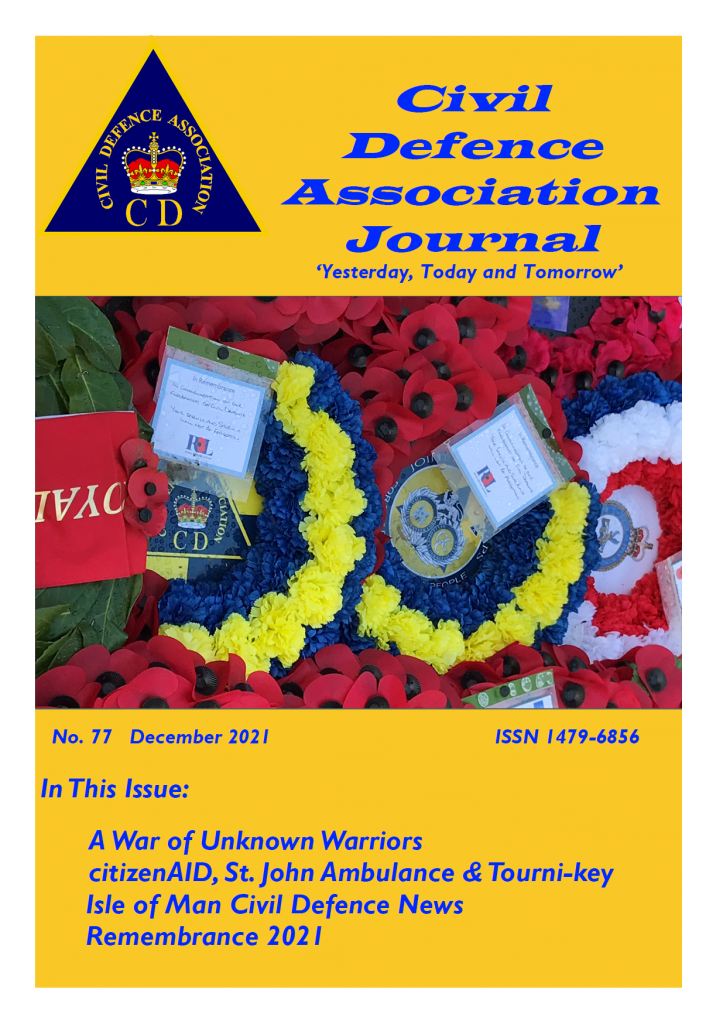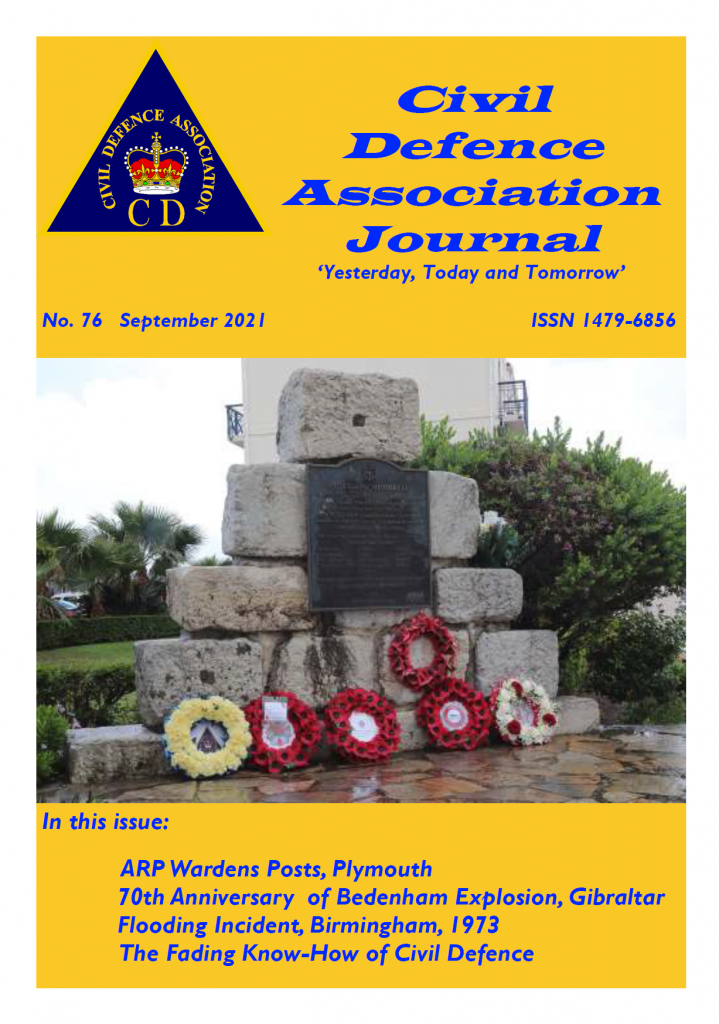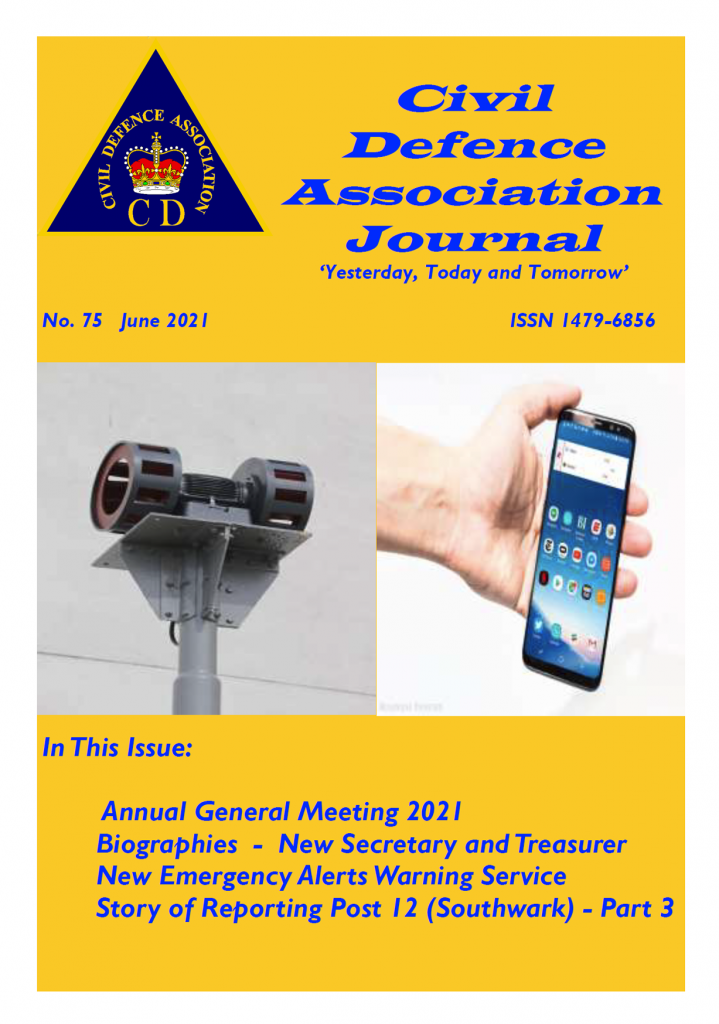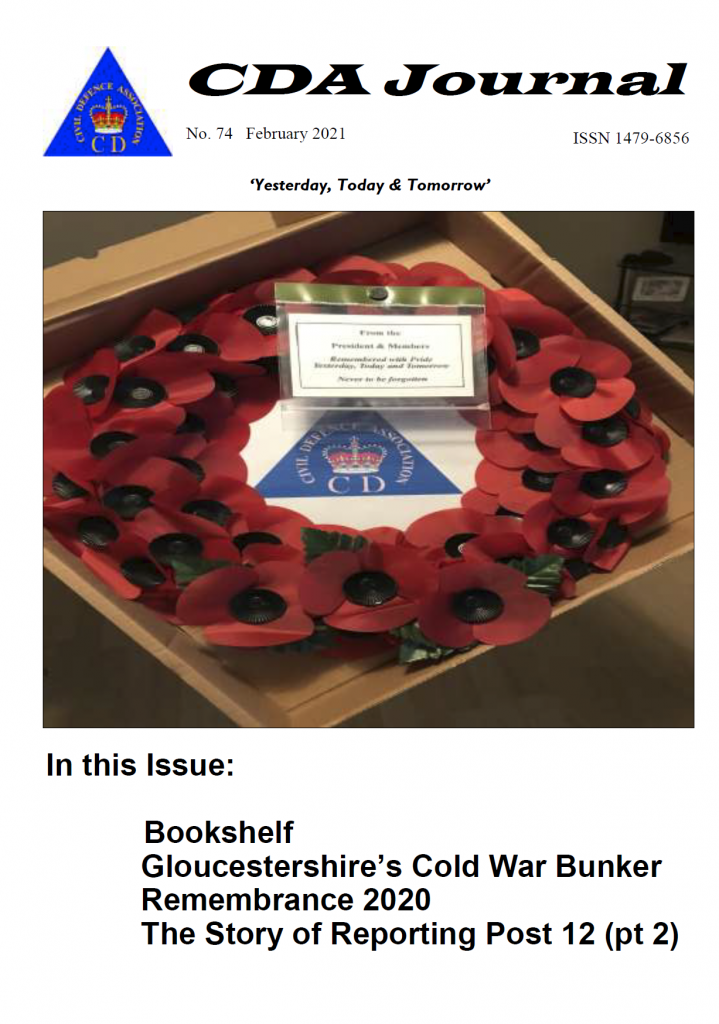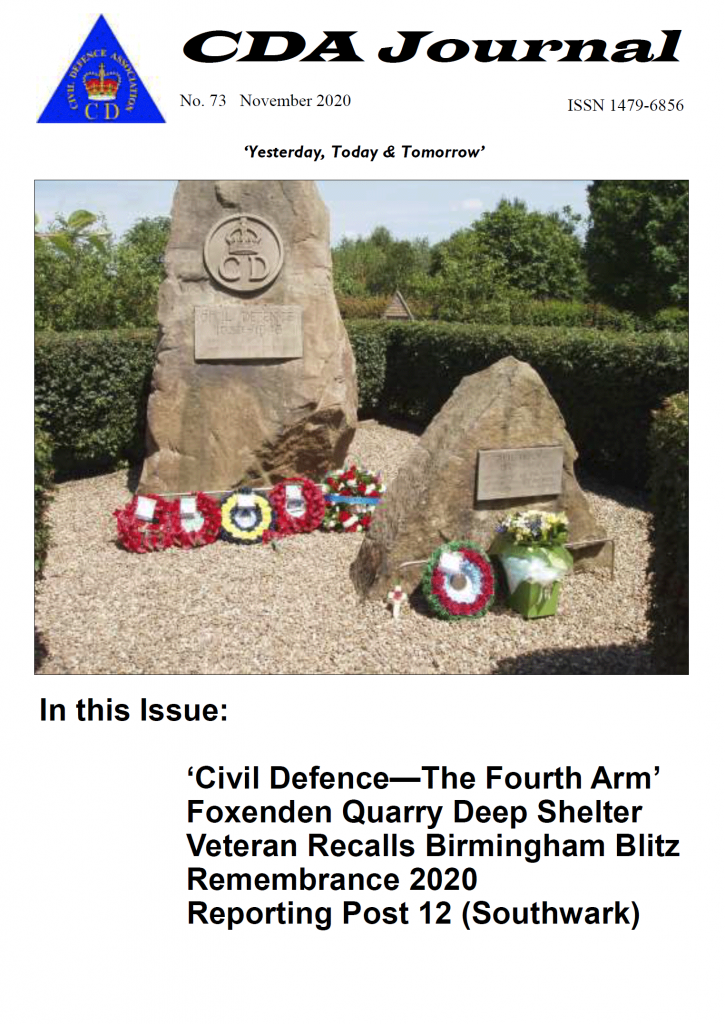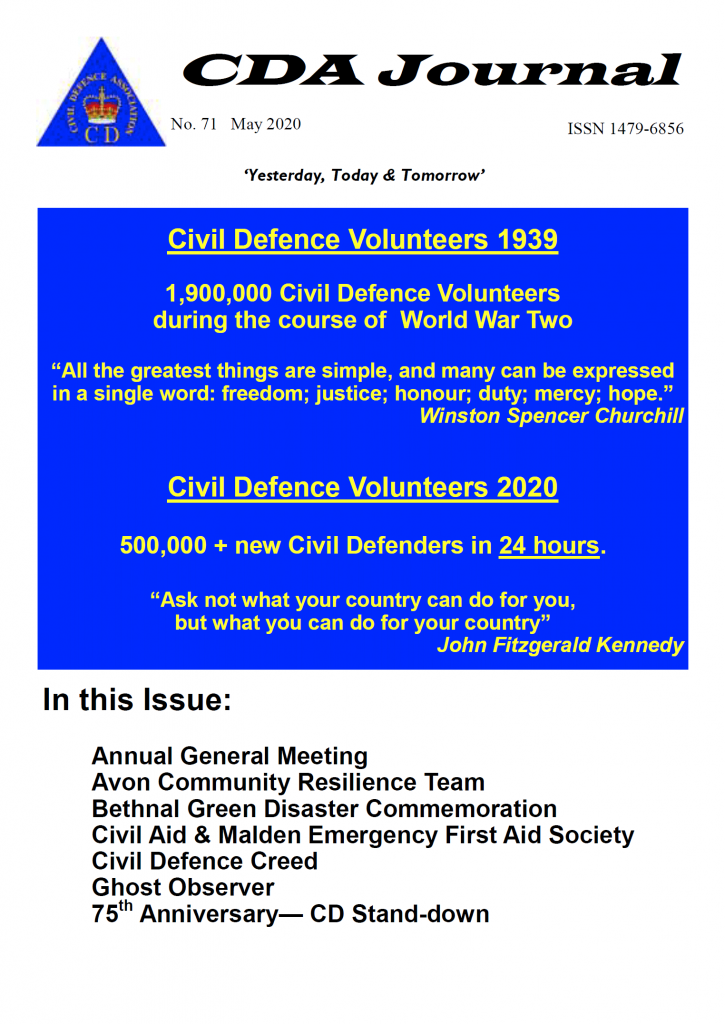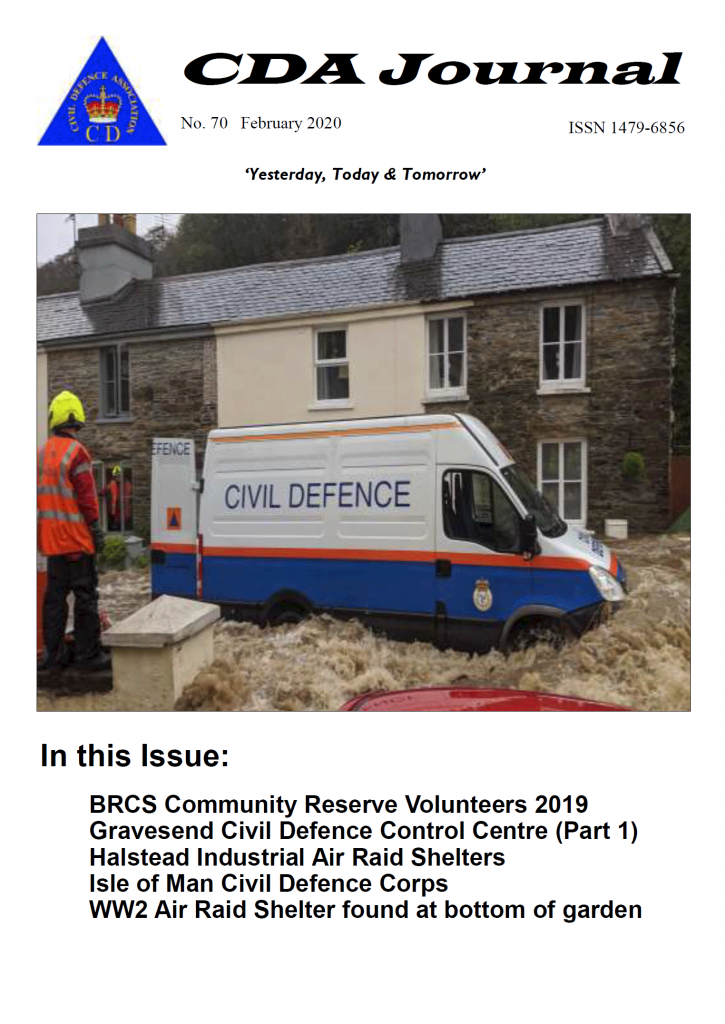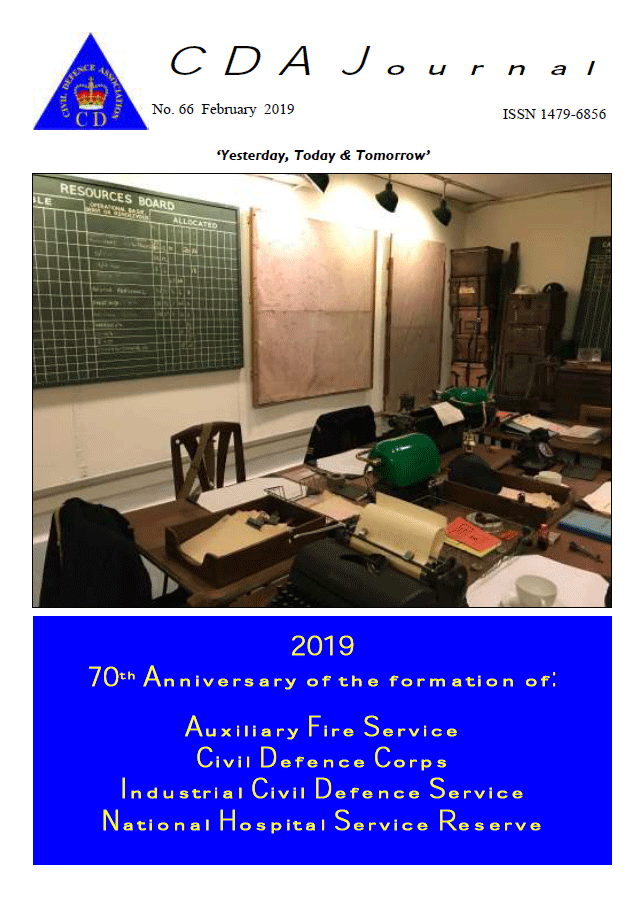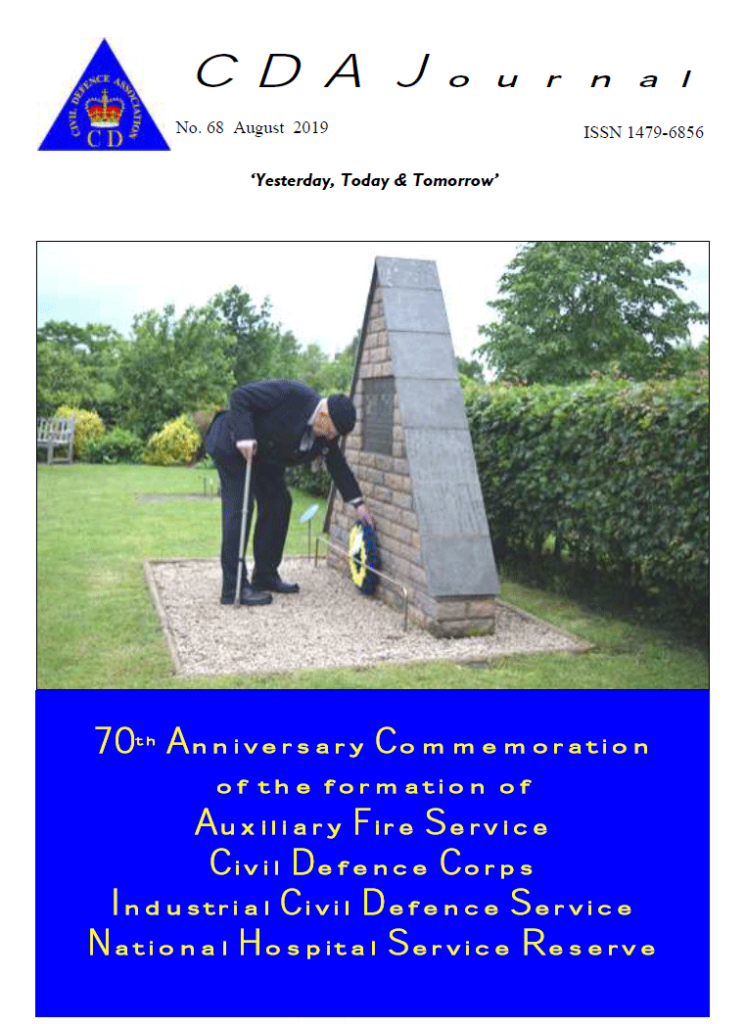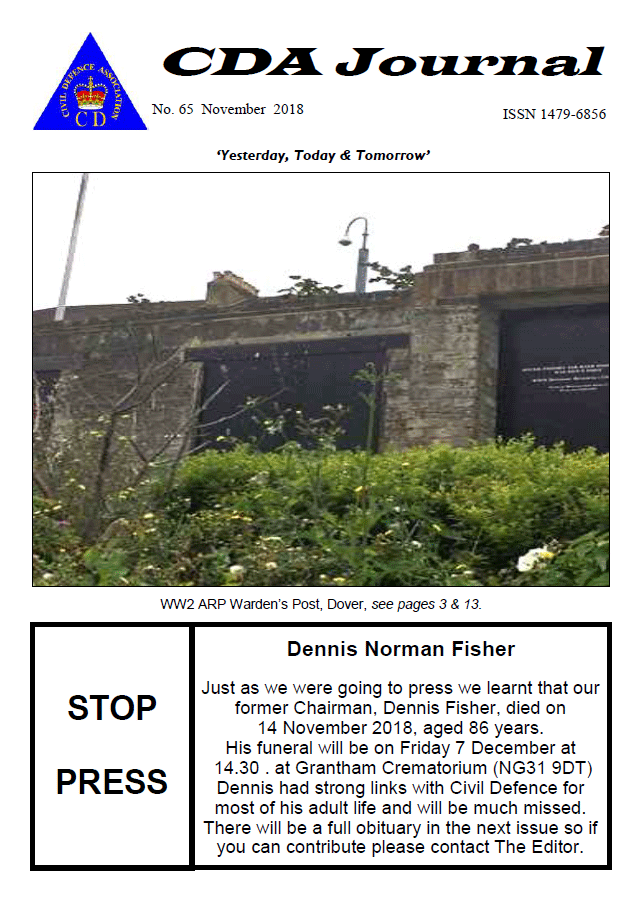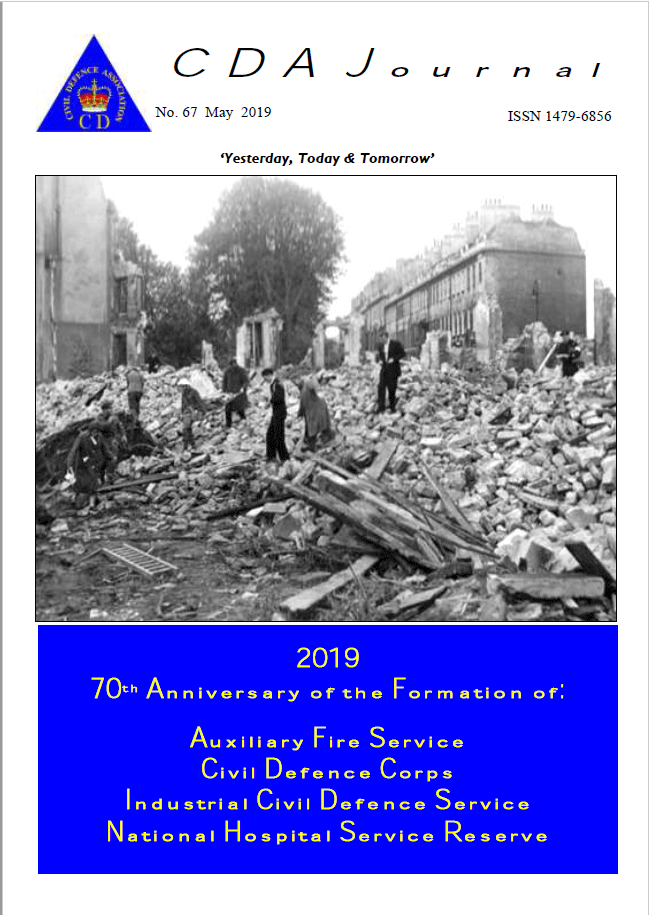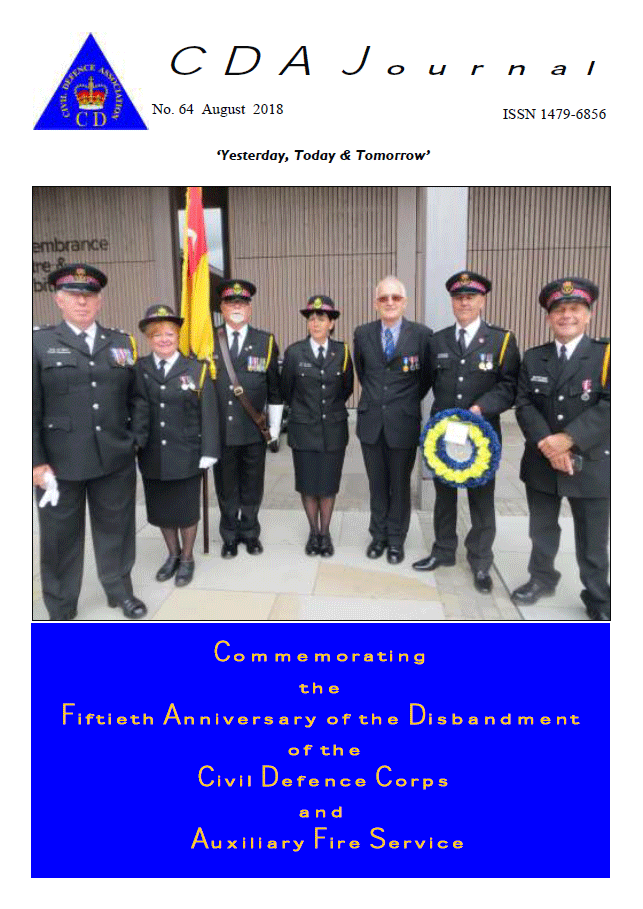Welcome to The CDA Journal
No. 77, December 2021
ISSN: 1479-6856
Yesterday, Today, and Tomorrow
Please see below for PDF downloads of the Journal.

Front Page Photograph: The CDA wreath laid together with others from kindred organisations at the foot of the Cenotaph, Whitehall, London on Remembrance Sunday, 14 November 2021.
Photograph: Terry Hissey.
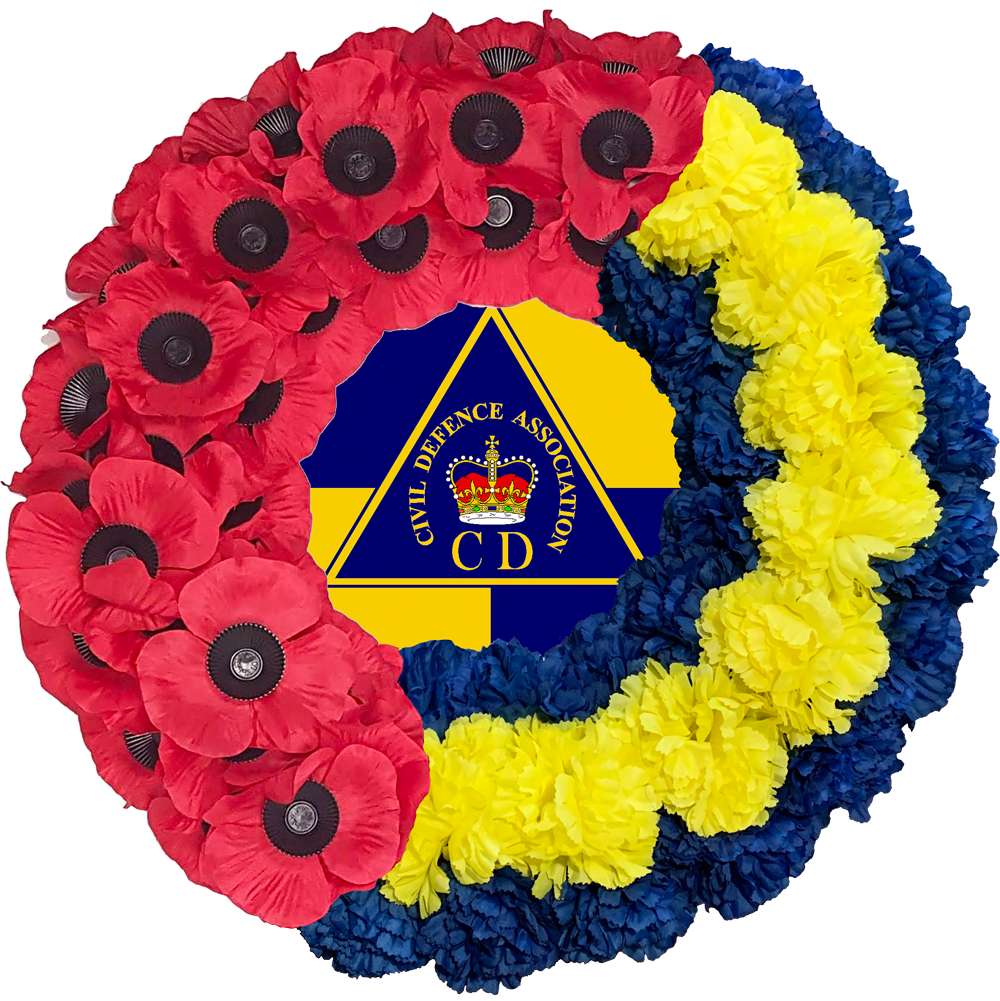
The Civil Defence Association wreath.

The Joint Civil Aid Corps wreath.
This year the Civil Defence Association and the Joint Civil Aid Corps changed to using a joint poppy and carnation wreath. The poppies obviously commemorate the fallen military, and the blue and yellow carnations commemorate the 7,000 Civil Defenders that died while serving on the Home Front during World War 2.
The Civil Defence Association Journal is published four times a year. Opinion expressed are those of the authors and are not necessarily those of the CDA.
The Editor welcomes articles, photographs etc. for inclusion. Articles may be submitted either handwritten or (preferably) typed or in Microsoft Word format.
Copy deadline for next issue is 15th February 2022.
Items may be reproduced by ‘not for profit’ publications provided due acknowledgement is given. Commercial publications contact the Editor in advance.
The CDA Journal is printed and published by the Civil Defence Association 24 Paxton Close, Matlock, Derbyshire DE4 3TD, England. Any electronic submissions can be sent to [email protected].
Contents of Journal 77
Editorial
Remembrance 2021
Obituary
Isle of Man Civil Defence News
‘Civil Defence—The Fourth Arm’
The Story of Reporting Post 12 (Southwark) – part 5
A War of Unknown Warriors
citizenAID, St. John Ambulance & the Tourni-key
Letter from America
Events
ARP & Civil Defence badges—WW2
Editorial
Welcome to the 77th edition of the CDA Journal.
2021 has been a year of contrasts, with the pandemic declining to the extent that most restrictions had been lifted—only for cases of Covid-19 infection to increase quite sharply in some parts of the UK. Except that now we have lateral flowing testing and the benefit of a continuing programme of vaccination.
So, what does the future hold in 2022? Well as far as the CDA is concerned we should start seeing the implementation of some of the proposals contained in the Chairman’s paper entitled ‘New Horizons’. The future development of the
Association will not be rushed but evolve over the next few years. To this end, your Officers and Committee have been working behind the scenes, including the holding of regular meetings utilising Zoom internet conferencing. One thing is certain however, and that is the firm commitment to expand the Association’s role, while remaining true to our motto ’Yesterday, Today and Tomorrow’.
I wish all our readers a Happy Christmas, and Peaceful New Year.
Stay Safe.
Graham Whitehead

Splendid you passed, the great surrender made; Into the light that nevermore shall fade.
REMEMBRANCE 2021
Field Of Remembrance

The after effects of the pandemic meant that the number of representatives from many organisations attending the Field of Remembrance was limited.
Once again we were so fortunate in that Colonel Sir Neil Thorne attended on our behalf.
I’m sure all readers will join me in expressing sincere thanks to Sir Neil for representing CDA at this very important national act of Remembrance.
Photograph: Amanda Harmsworth
Remembrance Sunday at the Cenotaph
The display of poppy wreaths at the foot of the Cenotaph is such a poignant sight and brings into sharp relief, the sacrifice of so many men and women who ’gave their tomorrow for our today’.
Photographs: Terry Hissey
We will remember them.
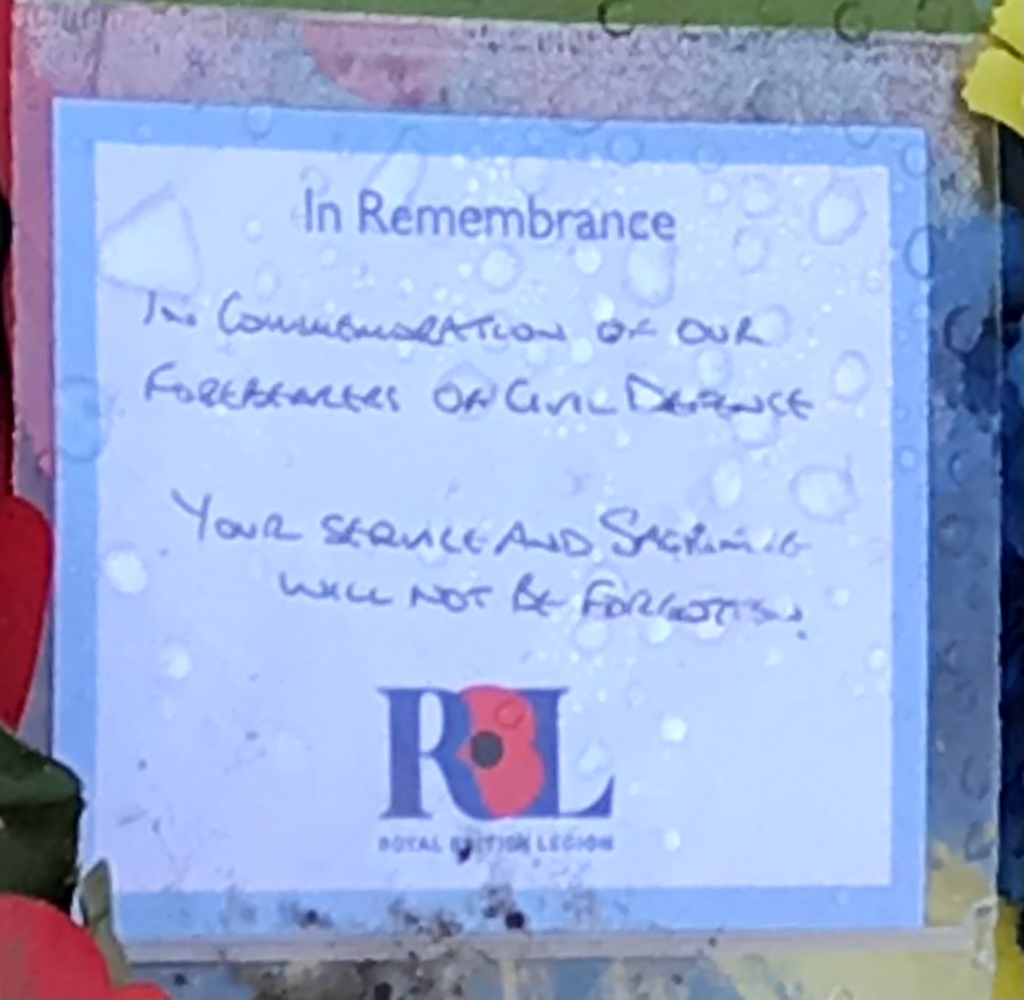
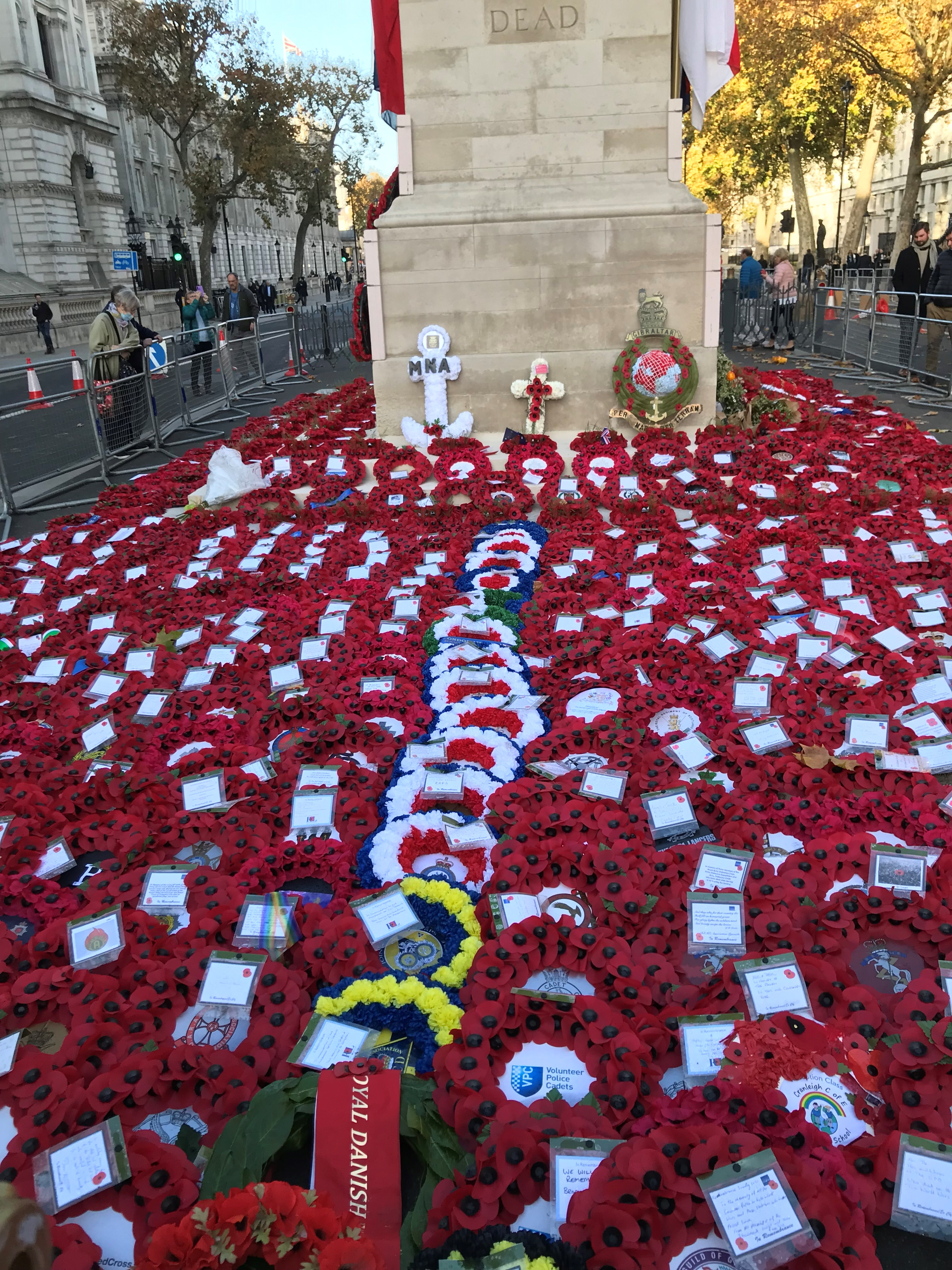
CDA Member Stuart Millson attended the Remembrance Sunday Service and wreath laying at East Malling, Kent.
Stuart is pictured on left wearing an LoF badge on beret and CD Corps armband.
He was accompanied by Wing Commander Mike Sutton.
Photograph: Daniel Markham.

OBITUARY
Dorothy Barbara Leather
Known as Barbara, she died 30 October 2021, aged 84, following a stroke 5 weeks earlier. Fortunately she was able to spend her last hours at home with members of her family.
Judith Essex-Lopresti had been in the same year at Secondary School as Barbara and, over the years, had become close friends. Indeed, there were godparent and bridesmaid links.
With Judith they had wanted to do something useful for the community, so they joined the Ambulance Section of the Birmingham Division of the Civil Defence Corps in 1955 which generated further friendships including Anne Hirons, Sue Dexter, Heather Howell and Pauline Harris.
In 1968 Barbara remained a volunteer by becoming a member of the Voluntary Civil Aid Service. She was a founder member of the Civil Defence Association and helped arrange the set-up AGM. She was elected as a Committee Member and served until March 2019.
She married Chris in 1959 and had 2 daughters, Helen and Ruth. In the mid-1960s Barbara, with toddler Helen, went along as passengers in a train crash exercise in Birmingham that involved all 4 Emergency Services.
Both daughters married and between them have given Barbara 5 grandchildren. They have been a great support to Barbara and Chris and, no doubt, will continue to support Chris through these difficult days and beyond.

MAY SHE REST IN PEACE
L to R,
Sue Dexter, Barbara Leather, Anne Hirons and Kath Foster with Anthony Stanton with flowers to be laid at the Animal Memorial stone in the Civil Defence Memorial Garden at The National Memorial Arboretum on 10 July 2010.
With sincere thanks to Helen Harper, and Tim and Judith Essex-Lopresti
ISLE OF MAN CIVIL DEFENCE NEWS

On the 6th May 2021, 4 members of the Isle of Man Civil Defence Corps were presented with their Long Service medals at a ceremony at Government House by the Lieutenant Governor Sir Richard Gozney KCMG CVO KStJ.
Following the ceremony a reception was held for friends and families at Government House.
A further member Allison Fox who was unable to attend the ceremony also received her Long Service medal this year.

L-R – Phil Styles, Pete Savin, Sir Richard Gozney, Nigel Smith, Ralph Jackson.
With thanks to Jane Kelly MCGI, Emergency Planning Officer, Emergency Planning and Civil Defence Unit, Isle of Man Government.
Editor.
‘CIVIL DEFENCE – THE FOURTH ARM’
BACKGROUND
Following the disbandment of the Civil Defence volunteer organisations in 1968, a considerable quantity of reports and articles relating to exercises and ’peacetime’ incidents were either lost or simply thrown away. The monthly magazine ‘Civil Defence—The Fourth Arm’ was one such important source of material. Reports etc., from all over the UK were sent to their editorial offices and provide a valuable insight into the role of volunteers during that period of the ‘Cold War’.
Thankfully, not all copies have been lost and I now have the years 1959—1967 in my possession. Using a system called optical scanning, I’ve started to record reports etc., for publication in the CDA Journal.
This an on going project, so if you have any copies of the ‘Fourth Arm’ publications, I would appreciate hearing from you. You can contact me via email: [email protected].
Thank you.
Editor.
POLICE MOBILE COLUMN EXERCISE
The Police C.D. Mobile Column has been in action in Lancashire during May, 1960 and members of Manchester C.D. Corps, along with other Divisions in the North West Region, had an opportunity of seeing the Column at work over the Weekend of May 14/15 at Oldham. At Exercise “Jack” on 14 May, members of the Rescue and Ambulance Sections with their vehicles and members of the Warden Section acting as attendants, assisted in the Police clearance of a supposed “Z” Fall-out Zone. The vehicles, in convoy, went from Manchester to Boundary Park, Oldham; there to function as “5/7-seater buses” under Police orders, detailed to travel to Ashton-under-Lyne (the “Z” Zone) to evacuate the inhabitants to railhead at Rochdale. The writer was not in a position to see the exercise as a whole, but it is understood that the Police are well satisfied with it and the lesson learnt — and speaking from one person’s viewpoint (the passenger seat of a noisy Ford truck) one must say that the turnout and marshalling of vehicles at Oldham’s Football Ground was an impressive sight; so also were all those Policemen — never has one seen so many!
Convoy travel had its lighter moments too; as for instance the episode of the Warden who unexpectedly found herself detailed as Platoon wireless operator and who, quite unversed in these mysteries, had travelled some distance before realising that the odd looking canister in the back of the van was in fact the Walkie- Talkie Radio — and had travelled another few miles before discovering the reason why, although she had switched on and tuned to the right channel she couldn’t hear anyone, was that she wasn’t listening in the right place! However, she was an experienced operator by the time she returned home!
“Rabbit” the second part of the project, took place on the Sunday morning and was a Convoy Exercise in which Manchester and other Divisions took part. An interesting footnote to the weekend’s activity is the fact that Manchester was able to give hospitality for Saturday night to the Barrow-in-Furness contingent at the C.D. Social Club at Nell Lane. It is not by any means every Division which can offer to visiting colleagues an evening meal, beds for the night, and breakfast — so the South Manchester Social Club justifies its existence again!
September 1960
EXERCISE “LITTLE DUNKIRK”
The Lancashire County Council C.D. Headquarters is fortunate in that one side of the boundary of the grounds has the Lancaster/Kendal Canal running along it. This fact, and the acquaintance of the C.D. Officer (Training) for Lancashire County Council, with the President of the Lancaster Canal Boat Club inspired a C.D. Exercise called “Little Dunkirk” run on 14 August, 1960. About five miles by water north of the C.D. Headquarters is the village of Catforth. It was assumed that this village had been cut off as a result of a nuclear explosion by all means of communication except by canal. It was assumed also that there were a large number of injured and homeless in the village, and the Sub-Area Controller concerned had, through his higher controls, asked for the assistance of the Lancaster Canal Boat Club who have a large number of pleasure boats on this stretch of canal.
Casualties in the village were given first aid treatment by a First Aid Party and Wardens and were carried down to the wharf at Catforth. There, with the assistance of the Rescue Section, were loaded on to boats and, under the command of the Commodore of the Boat Club, they moved off south down the canal. The Commodore was afloat and had radio to the Sub-Area Control who was on the wharf where loading was taking place. He controlled boat movements and fed boats to the wharf to be loaded. The trip by canal took approximately one hour. Boats arrived at Lea Wharf a few hundred yards from the C.D. Headquarters where they were unloaded and loaded into ambulances and taken to a Forward Medical Aid Unit (FMAU) provided by the Manchester Regional Hospital Board in the grounds of the C.D. Headquarters.
The FMAU sorted, treated and evacuated those casualties which needed hospital care to a simulated hospital. Homeless made their way on foot to a Rest Centre set up under canvas in the grounds of the C.D. Headquarters. At the end of the exercise a meal was served, to the 320 people who took part, by the C.D. Emergency Feeding Section, who cooked an excellent lunch using improvised cooking facilities.
After lunch the Chairman of the Lancashire County Council C.D. Committee, said a few words of appreciation of the way in which volunteers and members of the Lancaster Canal Boat Club had given up their time to make this exercise a success. This exercise also had the active support and co-operation of the British Transport Commission Water Ways Section. Many valuable lessons were learned as a result of the exercise which emphasised the importance of the use of Inland Waterways as a means of evacuation in an emergency.
October 1960
PRESTON’S BIGGEST EXERCISE
Preston’s biggest-ever C.D. exercise involving 700 men, women and children, ended with “thumbs up” all round. The four-hour emergency routine had proved its worth. Weeks of careful planning had gone into Exercise “Prestonian”—it brought the stark reality of nuclear warfare sharply into focus-but the vital operation closed on a note of quiet satisfaction . . . and hope. Hope that if Preston should be struck by the H-bomb terror, hundreds would be trained to salvage a small corner of civilisation from its trail of destruction. The Preston Civil Defence Corps, working in close conjunction with other volunteers, swung into action while most people were turning over for their Sunday morning lie-in. Clad in steel helmets, gum-boots and battle-dress, they stood by at their Warden posts for the message that was to tell them the south of Preston had been severely damaged by a nuclear bomb dropped on the Royal Ordnance Factory at Euxton at 0700hrs.
As soon as the message had been received at the C.D. headquarters in Glover’s Court, reinforcements were on their way from neighbouring towns. To augment the 100 Preston members in the mock “life and death” struggle, Blackpool, Burnley and Southport Corps each sent 25 volunteers, and Blackburn 30. Territorial soldiers from 288 L.A.A. Regiment and the 5th Loyals, based at Kimberley Barracks, were called in to act as stretcher-bearers for the “victims”, and warders from Preston prison formed rescue parties with the help of employees at the North-Western Electricity Board’s Ribble Power Station. Chief object of the exercise was to evacuate 150 casualties and between 100 and 150 homeless people from the damaged area by rail to the rest centre and Forward Medical Aid Unit at Courtaulds factory, Ribbleton. The damaged area was chosen because of the derelict property which could be utilised, and the proximity of the Maudland goods sidings where the special passenger train was standing by. It was the first time since 1931 that the branch line had been used by a passenger train and the only occasion such a train had run at the Courtaulds end.
Before the train left, the “homeless and injured”—Boy Scouts, Girl Guides and members of Old People’s Clubs—were carried on board by members of the Preston Police Special Constabulary. The train was away on schedule and the “specials” breathed a sigh of relief. Police controlled traffic and plotted routes in the area and at Courtaulds, doctors and nurses from Sharoe Green Hospital applied first aid to the injured. An emergency cooking team was stationed in the factory grounds, while in the office block a rest centre was set up for the benefit of the “homeless”. Full-time officers of Preston Fire Brigade led teams of about 150 auxiliaries to tackle three mock blazes resulting from the explosion. Eight jets were played on the first at the Park Hotel offices of Lancashire County Council, and two “bikini” floats with featherweight pumps were used from the Lancaster canal to tackle the second in derelict property in the Cold Bath-street area.
Lunch was provided for all volunteers engaged in the exercise at Fishwick Secondary Modern School, Downing-street and Frenchwood Secondary School. Summing up the exercise, the CDO said: “We are convinced it has been the biggest and most successful ever undertaken in Preston. It was the first time in Britain, that a train had been used for the evacuation of victims, and the idea had proved most successful. Our attention now inevitably turns to future years,” he added. “The co-operation of industry, police, fire service and Army authorities has been a highlight of -the exercise and we are anxious to maintain this vital link.”
December 1960
THE STORY OF REPORTING POST 12 (SOUTHWARK)
BACKGROUND
Information can be found in the November 2020 Edition of the CDA Journal.
Continued from the September 2021 edition of the CDA Journal…………………….
Editor.
To Control, “Flybomb on Post area”; to messengers, “Fetch incident flags and census books”. In the waning light the scene of devastation looked unreal—tottering walls, the faces of casualties coloured with the ghastly pink hue of brick dust, and surrounding streets now littered with glass and debris. Very quickly Civil Defence Services and the NFS were on the spot, roads were closed, and rescue work began. Sixteen casualties were sent to hospital, and eight bodies recovered from the wreckage.
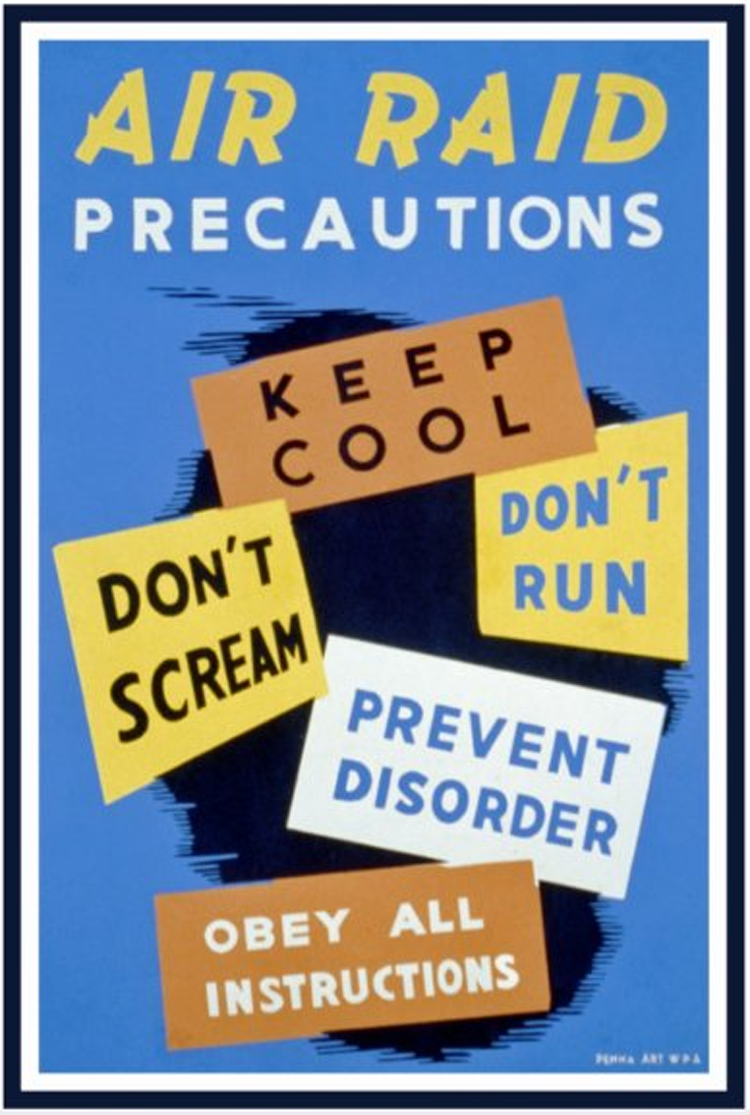
In addition, a number of minor injuries were treated on the site. Eleven houses were demolished, and many rendered uninhabitable. Three days later, on June 30, another flying bomb fell in Penrose Street, at 00.28 hours, demolishing buildings both sides of the road, and damaging the railway bridge. Rubble completely blocked the road and was lit by the light of fires which burned on either side. Eight men were rescued, some from an underground shelter, but two died in hospital. The damage, apart from that in Penrose Street, was comparatively light.
The troubles of Post 12, however, were not yet over. At 05.00 on the morning of Monday, July l7, a further flying bomb fell in Suffield Road, immediately in front of a block of shelters, the wall of one of which was blown in, killing two persons. Large four-storey blocks each side of the road crumbled into nothing, houses in five other surrounding streets were rendered uninhabitable, and blast damage extended even further. Dawn disclosed a desolate scene, but made the work of the rescuers easier. The first casualties had been cleared, and those who had been trapped now began to be rescued. One elderly woman who was dug out began to sing “The doodle-bug will get you if you don’t watch out” as she was taken away on a stretcher. Little did she know that the body of her husband had been recovered not so very long before. In spite of the damage, a number of older people had almost to be forced to go to the Rest Centres.
Forty persons were sent to hospital, and approximately 29 treated for minor injuries, including one old man who exposed a rather grubby foot showing no signs of hurt. He was promptly given a very cold compress. Another man was treated for no less than seven cuts from glass. Seventeen bodies were recovered——the biggest death roll the Post had ever had in one incident. These three flying bombs had killed in all 27 people, and seriously injured 91 others—a startling increase on the figures for the nine months of the Blitz, when 42 had been killed and 84 injured. The fly-bomb attack continued for another two months, but gradually its intensity decreased, due to the magnificent progress of the invading Allies, the over-running of the launching sites, and the increasingly effective defence measures. It was not until September, however, that the Civil Defence Services were able to relax. The Nazis continued to send the bombs over by launching them from aircraft, but Post 12 area did not suffer again.
The Hun then commenced to use his new weapon—the long-range rocket-but as this attack is still in progress, no details can yet be disclosed. Perhaps it is fortunate that Germany has made use of these long-range weapons, in what appear to be the last months of this war, because the people of Britain and Europe now know the form in which the Hun would wage a future war. With scientific progress, these flying bombs and rockets could be developed in size and accuracy of fire. Whole towns could be wiped out almost the moment that war was declared, assuming, of course, that the treacherous Hun complied with this formality. Let us, then, take notice of the future. Never again must Germany be permitted to devastate this country of ours. The solution will be in our own hands. When the time comes, let us see to it.
X. Conclusion
When the war is over and done with, maybe Wardens of Post 12 will look back with regret upon the days of happy comradeship, the friendly rivalry and brief glimpses of humour in days that were dark and nights of unceasing labour. Perhaps they will think of the Warden who searched for an anti-aircraft shell, finding it at last in his own house; or of the terrified householder who swore that his kitchen ceiling had been peppered with machine-gun bullets, and the anti-climax when he was informed that the “bullet holes” were drawing-pins left in the ceiling from Christmas festivities; of the shopkeeper whose shop front had been blasted away, and when asked the next day if the shop was open, replied “Cor blimey, It’s been open orl night”; and of the Warden who reported a red hurricane lamp as an incendiary bomb!
Many of the Wardens who served the Post during the Blitz have left for other spheres. Seven have passed away, but are not forgotten. Some have joined the Forces, others have left to continue their duties in other boroughs – they, too are remembered.
And so, at last, the story of Post 12 is told. The War continues. There are setbacks and advances; soon will come the last march forward, and Allied troops will enter Berlin, the centre of the tangled web of lies, untold cruelty and the bestiality of the Nazis. Until that day, Post 12 remains on guard, ready for action if the need should be.
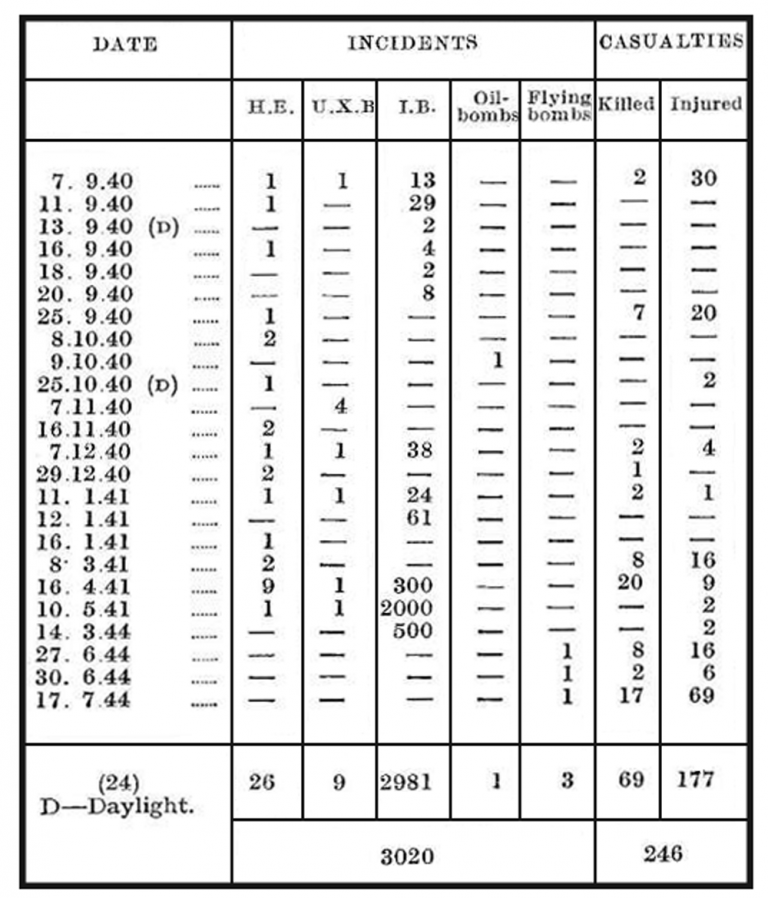
A. H. PULLIN (Author)
Deputy Post Warden, Post 12, Southwark.
December 1944.
Acknowledgements.
My thanks are due to my brother, Mr. J. E. Pullin, of Westbere, Kent, for his work in designing the front cover, and for useful criticism of the first draft; to Post Warden J. H. Barham for his help and advice, and also to Deputy Post Warden I. Zimmerman for further advice; to Mr. K. S. C. Dodd and Mr. J. Smillie, of Ashtead, Surrey, for useful suggestions for improving the text; to Warden Mrs. A. Holmes, who undertook the onerous task of preparing the Lists of Wardens and for other assistance, and to Warden F. C. Blainey for supplying the manuscript of the Post 12 song which he composed.
I am also grateful to Wardens F. C. Blainey, W. Hungerford, G. Mahoney and B. Woolf, and Deputy Post Warden I. Zimmerman for details of humorous incidents and other information which have been incorporated in the text.
This marks the conclusion of the Fifth and Final Part of ‘The Story of Reporting Post 12 (Southwark)’
Editor.
A WAR OF UNKNOWN WARRIORS
It is clear there were also many unpublished heroes on Leicester’s Blitz Night, 19-20 November 1940. For example, George Bernard Emmett, aged 45, of 43 Medway Street, was Group ARP Warden for Highfields. He had given distinguished service in the First World War. As a corporal in the 1/5 Leicestershire Regiment, Emmett was awarded the Military Medal ‘for gallantry and dedication to duty’, leading troops after their officer was wounded during the penetration of the Hindenburg Line, France, in 1918.

When a bomb landed on the corner of Leicester’s Highfield Street and Upper Tichborne Street, demolishing this large boarding house, ARP Group Warden George Bernard Emmett was blown over the railings of Leicester Synagogue, seen rear right. He received an official letter from Leicester’s Chief Warden for his actions that night.
On this night, Emmett was in the epicentre of this incident and was blown over the railings of the Highfield Street Synagogue, damaging his shoulder. Emmett tended the garden of the managing director of Corah’s hosiery, a large industry in Leicester, and Mr Corah paid for him to go to London to have his shoulder treated. Emmett’s wife also became a warden.
Three months after the raid, Emmett received a typed letter from Chief Constable and Chief Warden Mr Oswald J.B. Cole: “As Group Warden in the area most heavily damaged, you worked with untiring energy in organising your wardens and during the greater part, you were under fire. Your difficulties were increased by the fact that telephones at five of your posts were out of action. I am aware you absented yourself from work the day after the raid, so you could continue duties as warden. I shall be glad if you will accept not only my personal thanks, but also those of the citizens of Leicester, for the splendid way in which you carried out your responsibilities as a warden. I consider myself very fortunate in having such men as you and those who work under you in the Wardens’ Service.”
Also, it was the female ARP workers who impressed ARP Medical Officer Dr Duncan Porteous: “As the bombs whistled down, to see the young ambulance girls, without a smile, but without showing fear, impressed me more than anything else. They came to the incident, waited for casualties to be loaded, then took them to the First Aid Post.”
Dr Porteous also found one terrified young girl buried alive under a collapsed house, at the end of a tunnel of bricks: “A young man volunteered to rescue her and inched his way through, then brought the child out. This was one of the night’s most outstanding acts of courage.”
Some 108 Leicester citizens were killed that night, including six on ARP duties. Nowadays, when people talk of Second World War heroes, they commonly focus on daring fighter pilots or machine-gun-brandishing special forces. But, although their bravery is undoubted, these soldiers faced the enemy armed with weapons – the ARP services faced enemy bombs and bullets with nothing but their sense of duty.
When I think of Second World War heroes, I think of ARP personnel, such as Dr Garrett and his bomb-blasted St John team tending casualties at the Blitz’s epicentre. I think of Group Warden George Emmett injured on duty, or ‘unlikely hero’.
Warden John Higgott GM rescuing two children from a blazing building. I think of Inspector Jesse Weston directing rescue operations as bombs fell all around. I think of AFS and NFS crews fighting fires as bombs and flames threatened to engulf them and I think of police officers Detective Sergeant Leonard Norman and Detective Constables Brian Hawkes and Edwin Trump, plus Wardens Bernard Alderson and William Pratt, killed by bombs as they went to help others.

ARP Group Warden George Bernard Emmett
This article and photographs is extracted from Tested By Bomb and Flame: Leicester Versus Luftwaffe Air Raids, 1939-1945, by Austin J Ruddy, published by Halsgrove Books. Signed copies are directly available from the author on 07812 038781 for £19.99. Editor

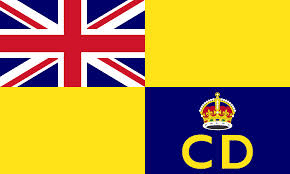
Emmett also continued to serve in the post-war Civil Defence Corps, seen here, wearing his First and Second World War medals, including the Military Medal
ST JOHN AMBULANCE, CITIZEN AID & THE TOURNI-KEY

As part of an enhancement of capability, St John Ambulance volunteers are being trained in the use of Tourni-Keys when they complete ‘return to role’ training, in line with the charity increasing first aid provision as COVID-19 restrictions ease.
Chair and co-founder of citizenAID, Mr Andrew Thurgood said: “This collaboration between the two charities is a significant milestone in citizenAID’s short history. There is real synergy in what we are doing here, the ability to work with a large and influential international organisation such as St John Ambulance
allows us to spread our simple public messaging further on how to save lives.”
“It is hugely exciting to see St John Ambulance volunteers training to use the Tourni-key. We are very grateful for the support of St John Ambulance, as without their shared vision, we would not have reached this historically important point.”
Major General Tim Hodgetts, co-founder of citizenAID and the UK Surgeon General, gave detailed evidence at the Manchester Arena Inquiry of the value of publicly delivered life-saving interventions in a multiple casualty incident.
He said, “The award-winning citizenAID system, presented in an app and pocket guide, [including the use of a tourniquet for life threatening limb bleeding uncontrolled by simple measures such as direct pressure] has learned from military medical experience that empowers soldiers to save lives when providing first aid to those injured by blast, gunshot or blunt trauma, and has contextualised this for use in the civilian setting.”

Designed and manufactured by citizenAID®, the Tourni-Key PLUS combines a novel tough plastic lightweight device, a triangular bandage to act as an effective tourniquet to stop severe bleeding from an injured limb and an anti-pinch card to stop skin bunching. The back of the packaging has the Tourni-Key contents. Further information can be obtained from www.citizenaid.org
With acknowledgements to citizenAID and St. John Ambulance. Editor.
LETTER FROM AMERICA

Thinking the unthinkable…..
We must dare to think “unthinkable” thoughts. We must learn to explore all the
options and possibilities that confront us in a complex and rapidly changing world –
J. William Fulbright.
Here we are at the start of new week; new challenges, new opportunities; new realities.
I’m thinking that most of us have been trying to get used to the “new reality” of things for about three weeks now and it might be starting to get a little old.
Maybe now is the time to harken back to a time our lives when things were fresh, new and unique to capture that sense of creativity and adventure.
I’m a big believer in the law of averages. I may come up with 100 ideas; 99 of them may be total duds but the 1 idea might be what is exactly needed at that moment. If we all take enough chances, sooner or later, the one chance we take will be the one that sets the everything in motion.
With Appreciation to Eugene M. Giudice, MBA, MLIS (CDA Member, Chicago, USA).
Editor.
CHRISTMAS GREETINGS

STOP PRESS & FOR THE RECORD
For Events, please visit our Events Page (Click below).
FOR THE RECORD
Birmingham Air Raids Remembrance Association.
Meetings are held January to November, every third Thursday of the month at 12 noon.
Updates on Association projects, meal and a chat.
Venue: Brasshouse, 44 Broad Street, Birmingham, B1 2HP.
All welcome.
Contact: Anita Ward, Tel: 07792 300261
The BARRA notice has been updated, so please make a note of the changes.
It may be of some comfort.
It may be of some comfort and reassurance for next of kin of deceased CDA members to know that arrangements can be made for a Civil Defence coffin flag to be dispatched, often at quite short notice, to be used at the funeral. Please be assured that such a request will be handled with sensitivity and discretion.
In such instances, the Secretary should be contacted via: [email protected] or 07377 721768.
Members and Families may also like to know that Deceased Members of the CDA have been added to the roll of the Perpetual Mass Association at the Benedictine Monastery of the Holy Cross in Chicago. Thus they will share in the spiritual benefits of the monthly mass and the daily office of the monks.
REMEMBRANCE 2021
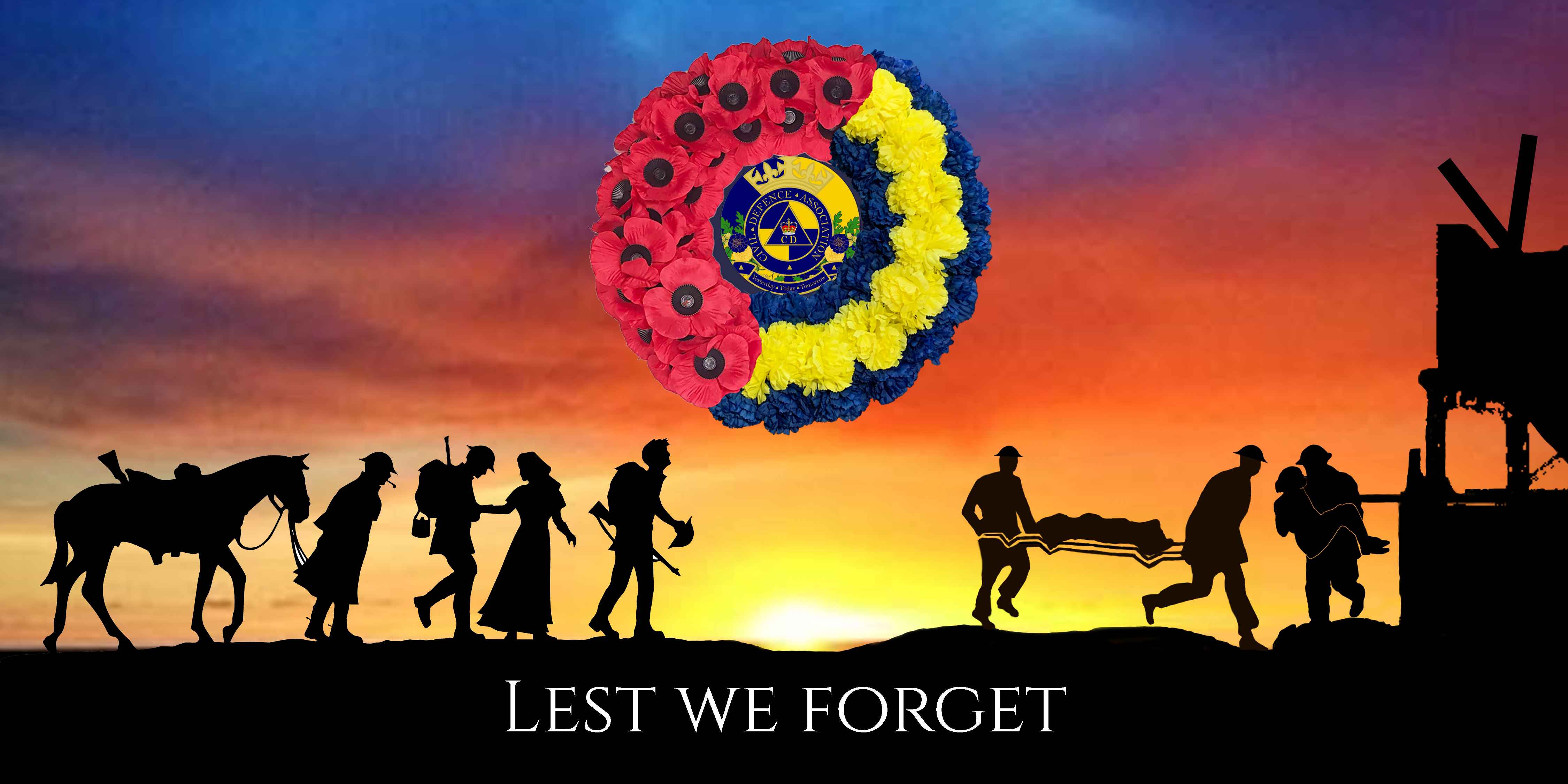
Picture by Colin Harmsworth
At the going down of the sun, and in the morning,
WE WILL REMEMBER THEM
In Remembrance of the 1,900,000 men and women of all the Civil Defence Services who served during the Second World War, 7,000 of whom made the ultimate sacrifice, and all those who have served within Civil Defence services since.
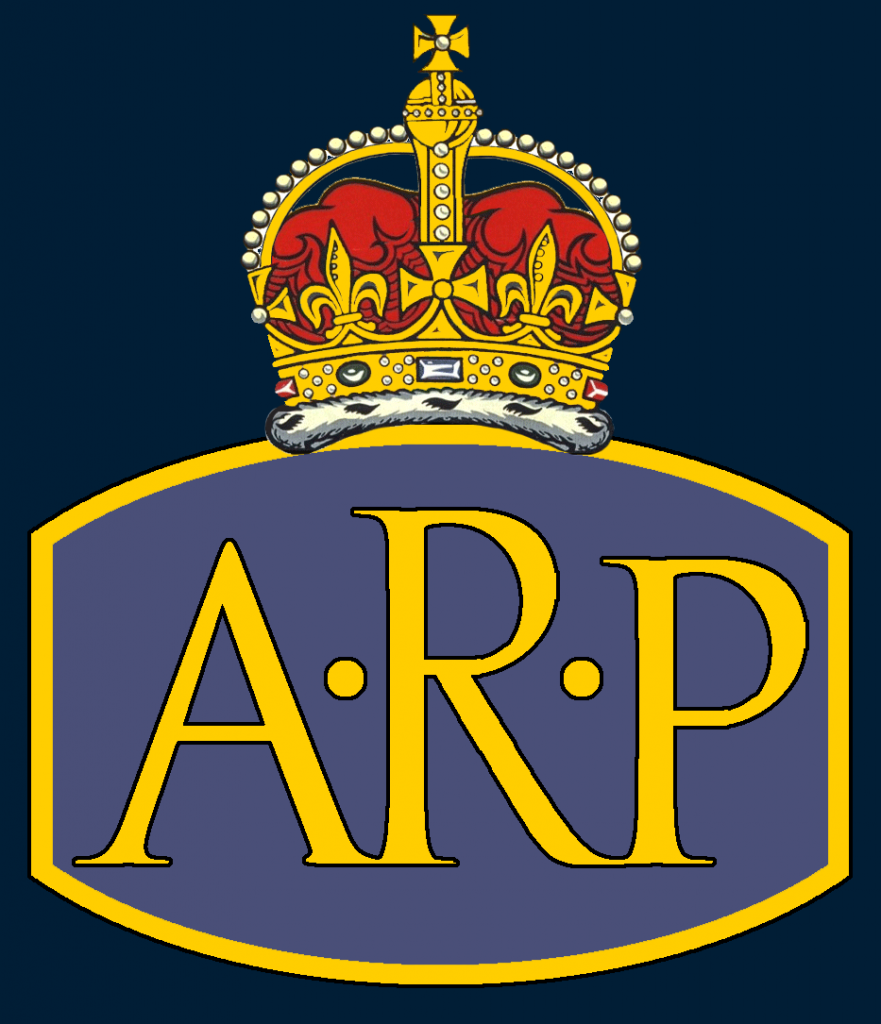
Air Raid Precautions
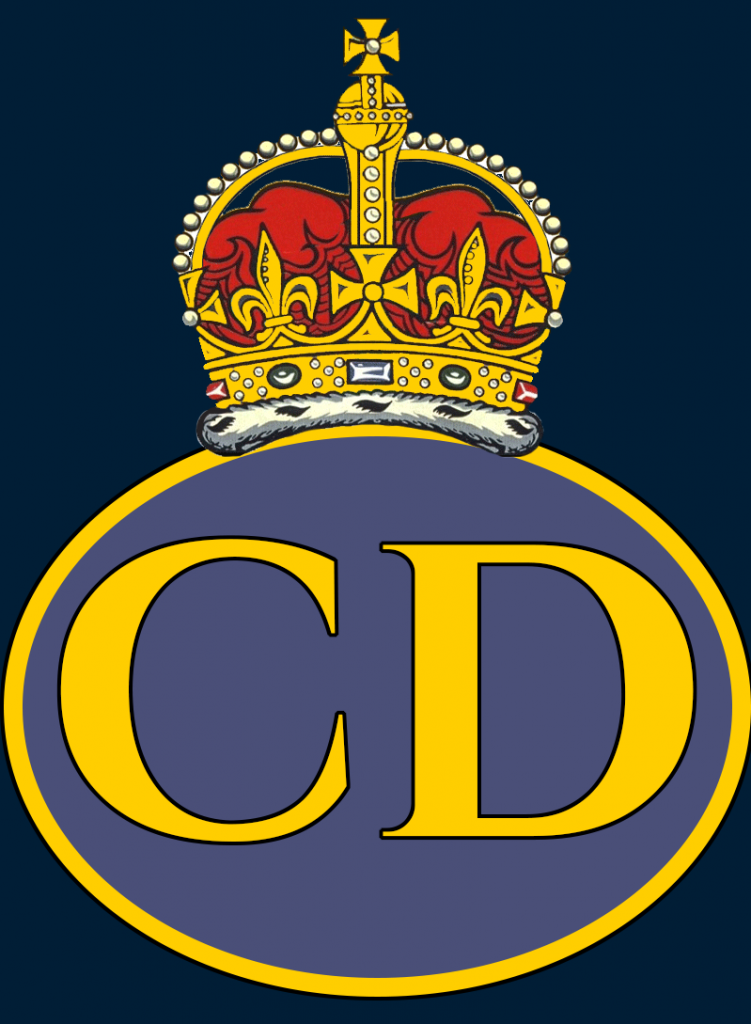
Civil Defence Service
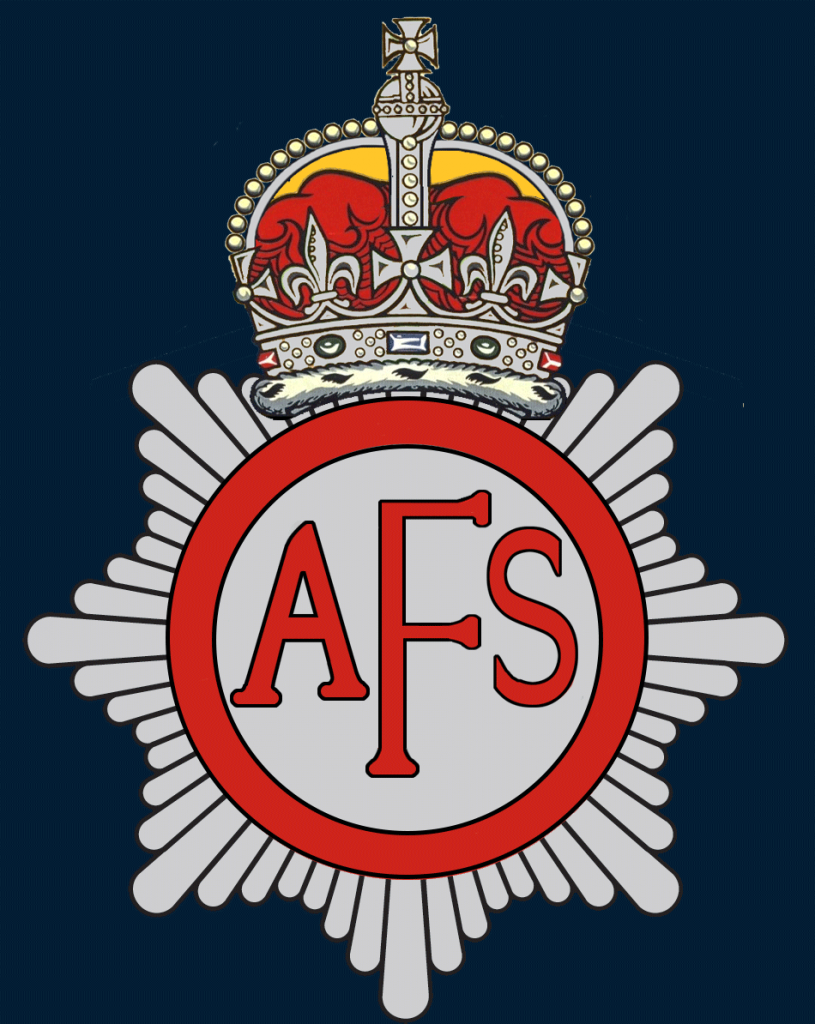
Auxiliary Fire Service
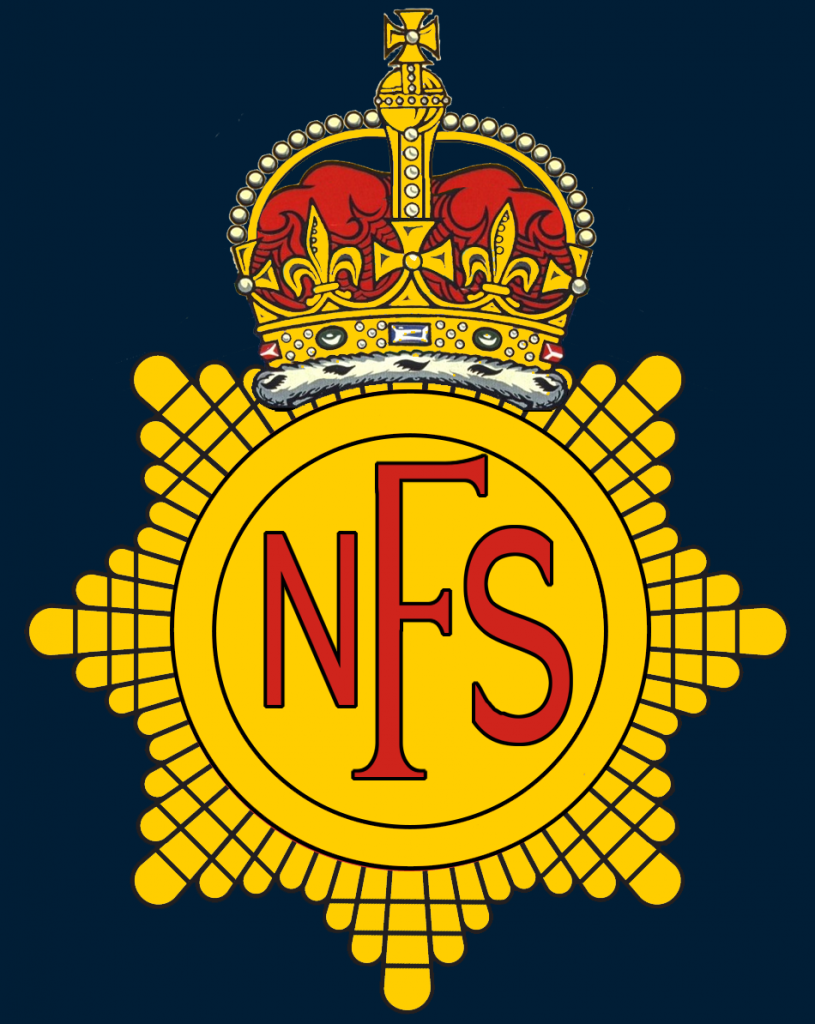
National Fire Service

Womens Voluntary Service
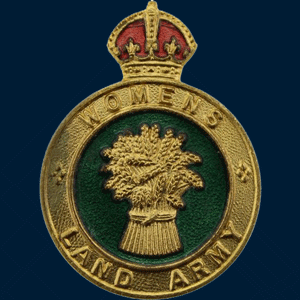
Womens Land Army
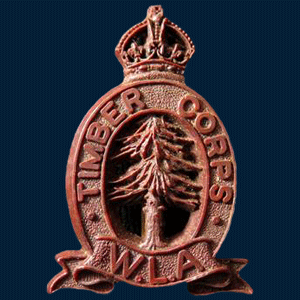
Womens Land Army Timber Corps

Inland Waterways National Service
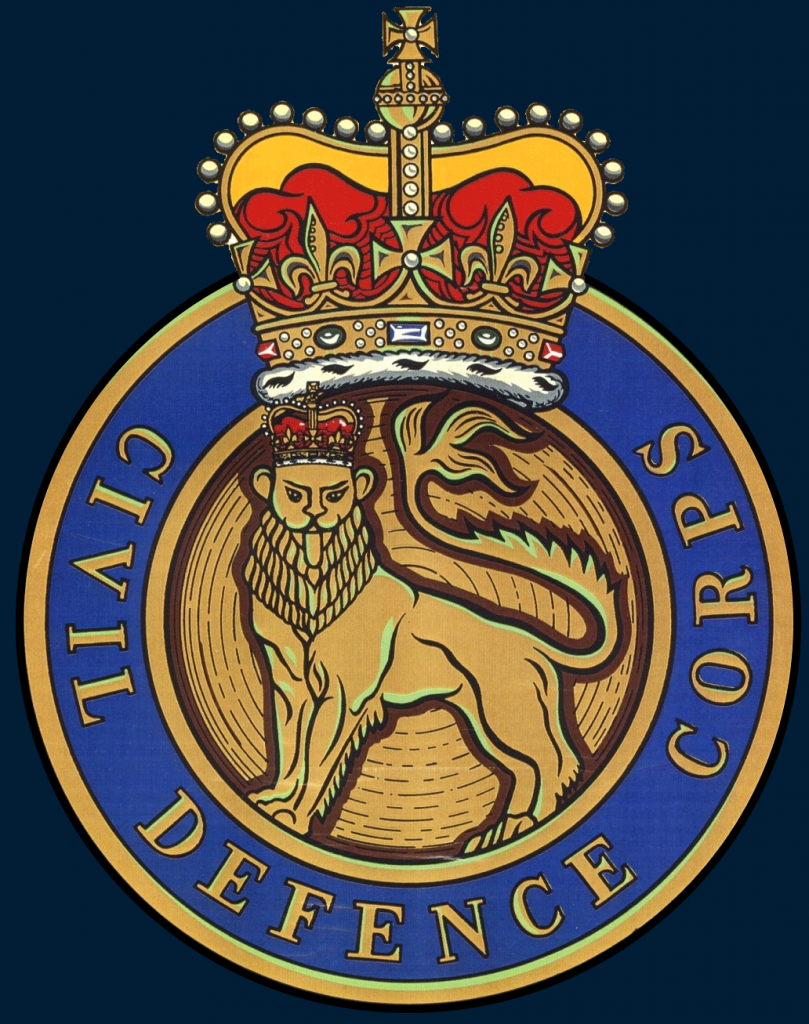
Civil Defence Corps
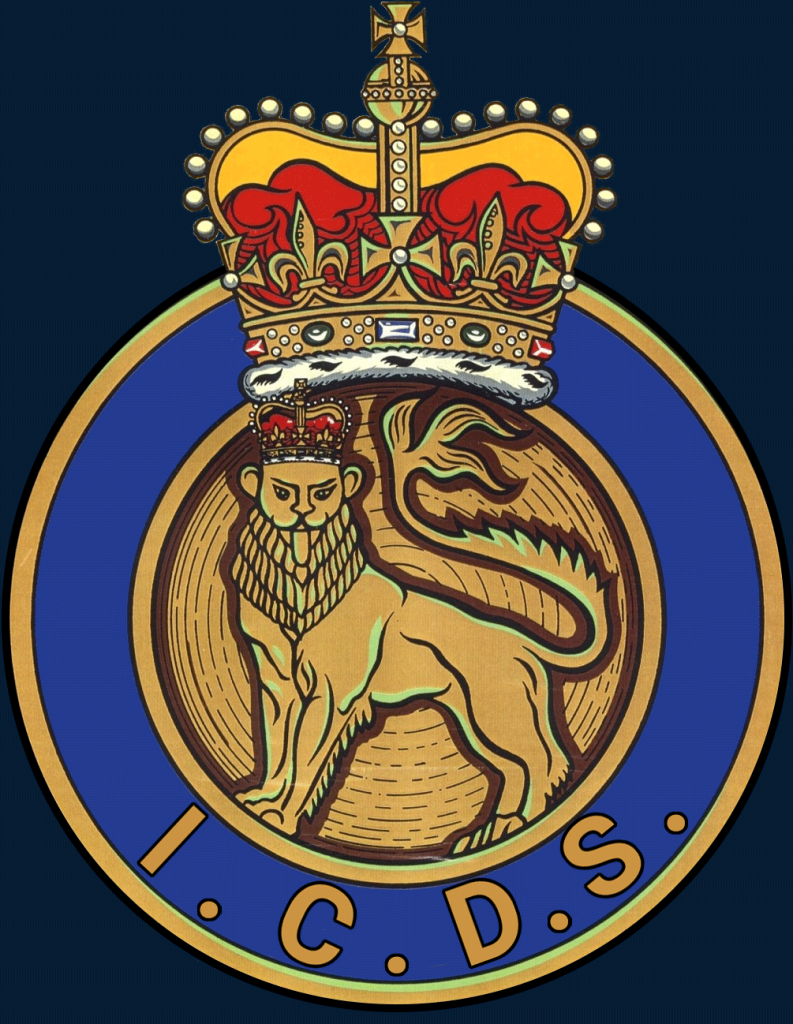
Industrial Civil Defence Service
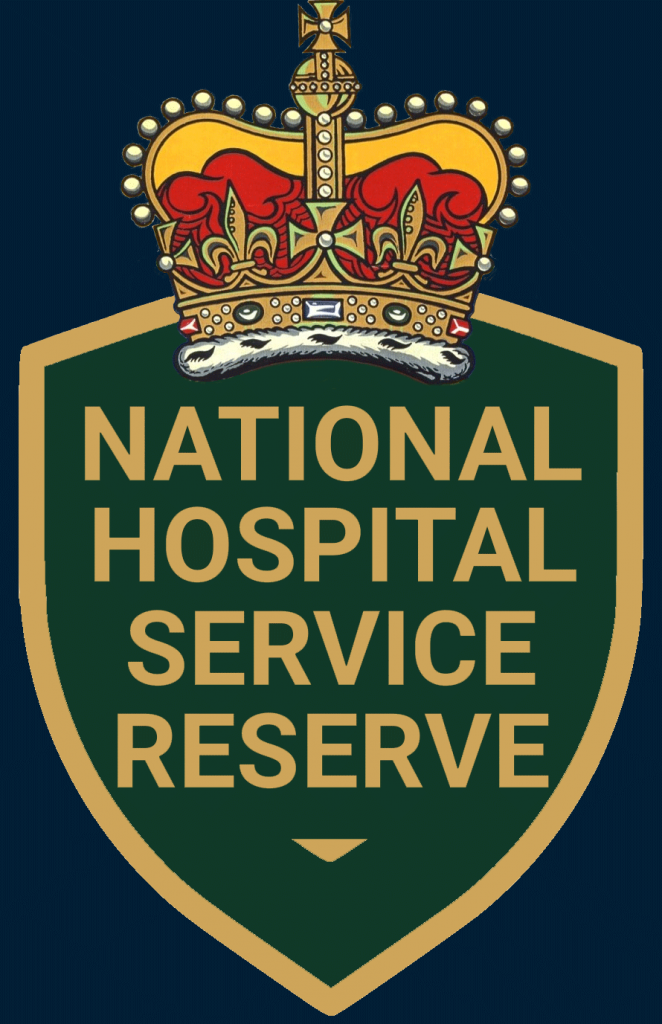
National Hospital Service Reserve
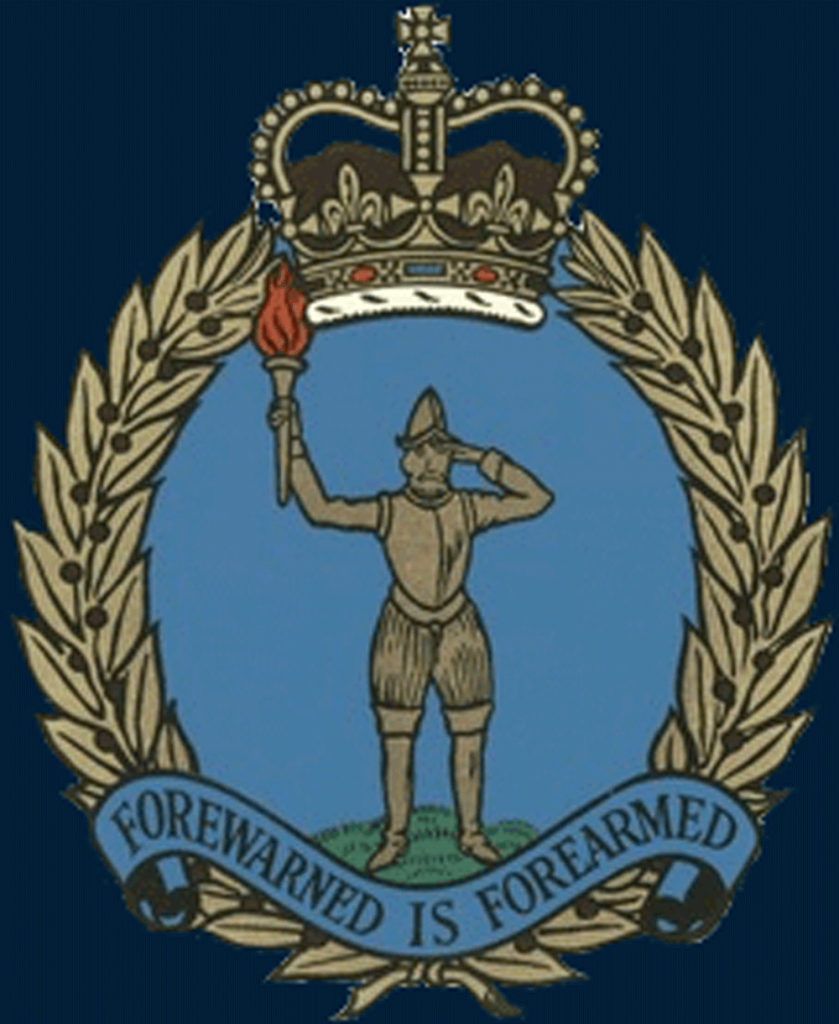
Royal Observer Corps
ARP & CIVIL DEFENCE BADGES—WW2
My attention was recently drawn to the appearance of a set of World War Two vintage ARP/CD badges on eBay uk.
The majority of badges were produced by companies who took an active part in civil defence measures. All appear to be in ‘mint’ condition so have obviously been well looked after.
Have you dear reader, any ideas where/who they came from and what price they raised at auction?
With thanks to Terry Hissey. Editor.

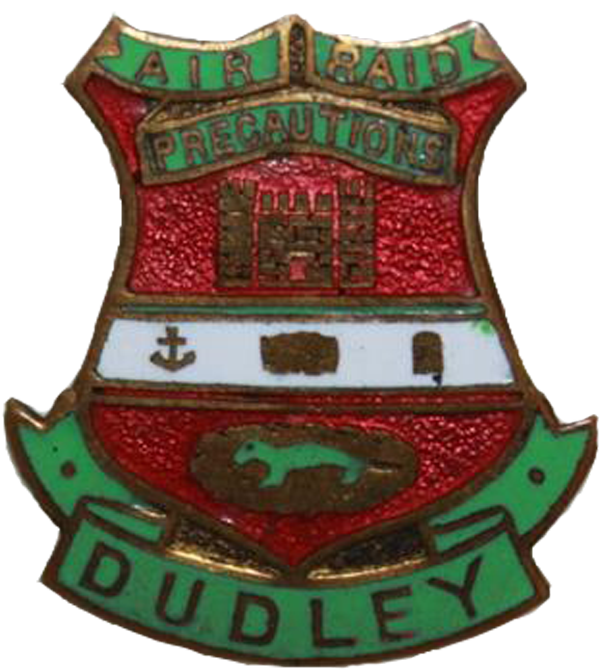
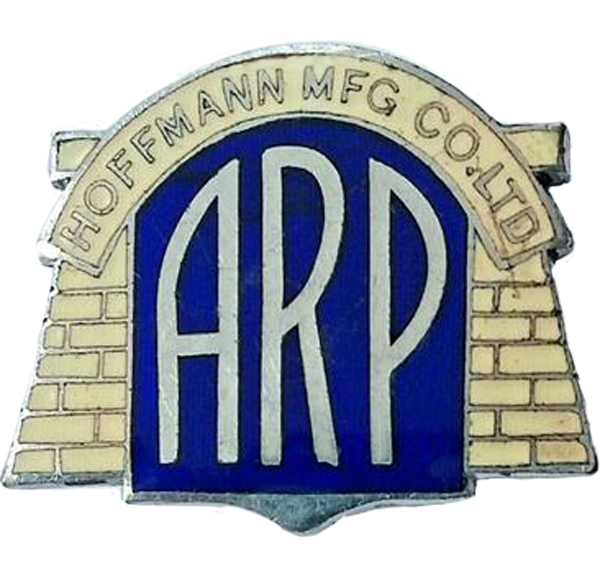
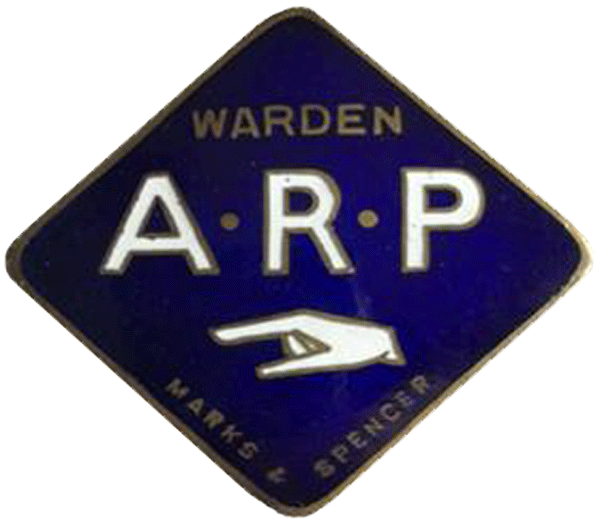

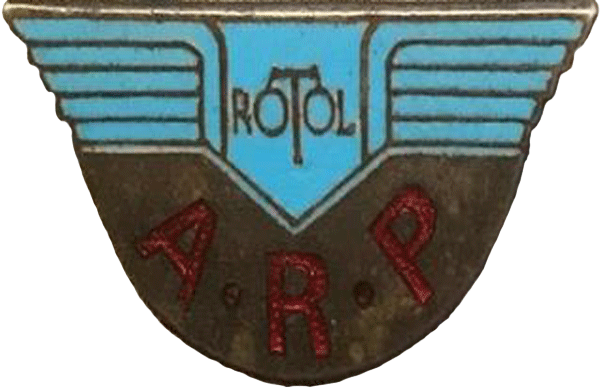

Journal Downloads (PDF Format)
Please feel free to download the Journals

